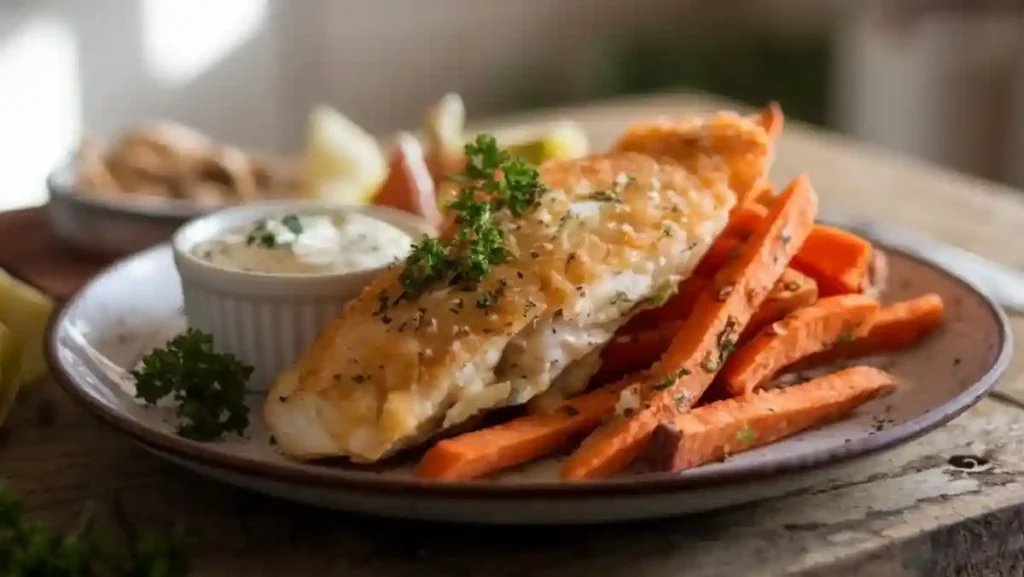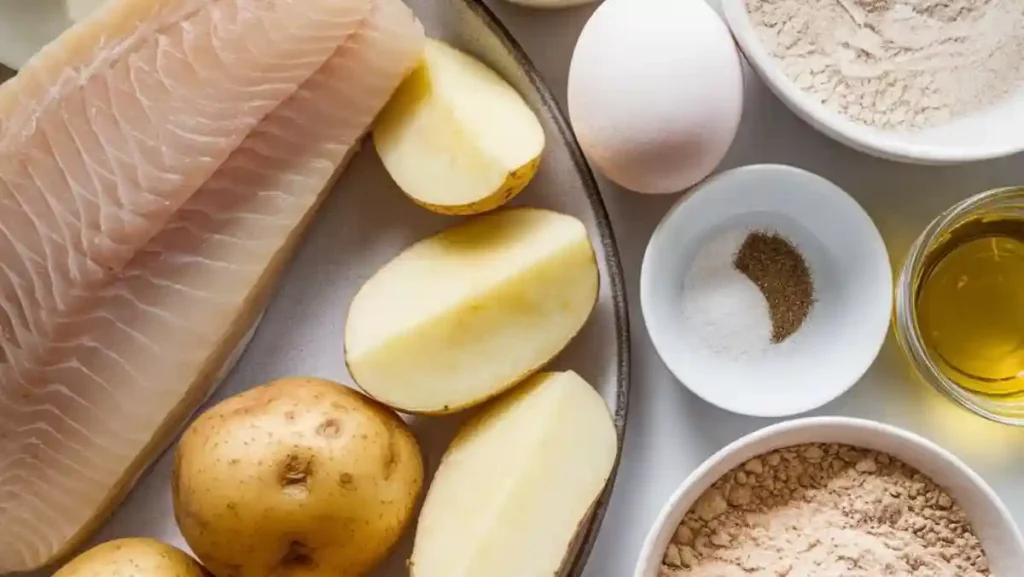Fish and chips are a beloved classic, but what if you could enjoy this comforting dish in a way that’s both healthy and lectin-free? For those following a lectin-free lifestyle, avoiding certain plant-based proteins found in grains, legumes, and nightshades is key to feeling their best.
This recipe reimagines traditional fish and chips with wholesome, lectin-free ingredients that are just as crispy and satisfying as the original. By using alternative flours, healthy oils, and nightshade-free options for the fries, we’ve created a guilt-free version that doesn’t compromise on flavor or crunch.
Whether you’re hosting a celebration or looking for a new family favorite, this lectin-free fish and chips recipe is easy to make, full of goodness, and sure to impress everyone at the table. Let’s dive into how to create this delicious twist on a timeless dish!
Table of Contents

What Makes This Fish and Chips Recipe Lectin-Free?
For many people, the journey to healthier eating begins with understanding lectins—plant-based proteins found in grains, legumes, and nightshades that some believe can irritate the gut lining and contribute to inflammation. While not everyone needs to avoid lectins, those who do often experience improved digestion, energy levels, and overall well-being.
This recipe swaps traditional ingredients for lectin-free alternatives, making it a safe and delicious option for those following a lectin-free lifestyle. Instead of wheat flour or breadcrumbs, we use cassava flour, a versatile and gluten-free option derived from the cassava root. For extra crispiness, arrowroot starch or coconut flour can be added to the mix.
By focusing on natural, whole-food ingredients like wild-caught fish, avocado oil, and lectin-free flours, this recipe not only meets dietary needs but also enhances the flavor and nutritional profile of this classic dish. It’s a perfect combination for both your health and your taste buds!
Essential Ingredients for Lectin-Free Fish and Chips

Crafting the perfect lectin-free fish and chips starts with selecting the right ingredients. Here’s what you’ll need for this healthier twist on a classic dish:
Main Ingredients:
- Wild-Caught Fish: Opt for fresh cod, haddock, or another flaky white fish. Wild-caught options are not only more flavorful but also free from added hormones and chemicals.
- Cassava Flour: A gluten-free, lectin-free flour that creates a light and crispy coating.
- Arrowroot Starch: Enhances the batter’s texture for an extra crunch.
- Avocado Oil: Ideal for frying due to its high smoke point and rich, nutty flavor.
- Sweet Potatoes or Parsnips: A lectin-free alternative to traditional potatoes for the fries.
Substitutions for Dietary Preferences:
- Gluten-Free: Stick with cassava or coconut flour as your batter base.
- Low-Carb: Replace cassava flour with almond flour for fewer carbs, and consider zucchini fries instead of sweet potatoes.
- Nightshade-Free: Use parsnips, carrots, or rutabaga in place of regular or sweet potatoes for your fries.
The Importance of High-Quality Oils
When it comes to frying, the type of oil you use can make or break both the flavor and health benefits of the dish. Avocado oil is a top choice for its high smoke point and neutral taste, making it perfect for achieving golden, crispy results. Extra virgin olive oil is another great option, especially for shallow frying or roasting the fries. Avoid processed oils like canola or vegetable oil, which may contain unhealthy fats and additives.
Step-by-Step Guide to Making Lectin-Free Fish
Creating crispy and flavorful lectin-free fish is easier than you think. Follow these simple steps to prepare a dish that’s both satisfying and guilt-free.
1. Preparing the Fish
- Choosing the Fish: Start with wild-caught cod, haddock, or any firm white fish. Wild-caught options are rich in nutrients and free of harmful additives.
- Seasoning the Fillets: Pat the fish fillets dry with a paper towel to remove excess moisture. Season both sides generously with sea salt, black pepper, and a pinch of garlic powder or paprika (optional) for extra flavor.
2. Creating the Batter
- Base Ingredients: Combine cassava flour, arrowroot starch, and a pinch of sea salt in a shallow bowl.This blend results in a light and crispy crust.
- Liquid Mix: In another bowl, whisk together water or sparkling water (for added fluffiness) and an egg. This will ensure the batter adheres to the fish.
- Coating the Fish: Dip each fish fillet into the liquid mixture, then dredge it in the dry flour mix, ensuring an even coating.
3. Frying or Baking the Fish
- Frying Method:
- Warm avocado oil in a deep skillet or frying pan over medium-high heat. Ensure the oil is hot enough by testing with a small drop of batter—it should sizzle immediately.
- Fry the coated fillets for 3–4 minutes per side until golden brown and crispy. Take the fish out and place it on a plate lined with paper towels to absorb any excess oil.
- Baking Method:
- Preheat your oven to 400°F (200°C). Arrange the coated fillets on a baking sheet lined with parchment paper.
- Spray the fillets lightly with avocado oil and bake for 15–20 minutes, flipping halfway, until the coating is golden and the fish is cooked through.
How to Make Nightshade-Free Fries
Fries are a classic side to fish and chips, but traditional potatoes belong to the nightshade family, which can be problematic for those avoiding lectins. Thankfully, you can enjoy crispy and flavorful fries using lectin-free alternatives like sweet potatoes or other root vegetables.
1. Alternatives to Traditional Potatoes
- Sweet Potatoes: A naturally sweet and lectin-free option, perfect for fries.
- Parsnips: Slightly sweet with a unique flavor that crisps up beautifully.
- Rutabaga or Carrots: Both are lectin-free and make delicious, colorful fries.
2. Cutting and Seasoning the Fries
- Cutting: Peel the root vegetables, then slice them into uniform sticks for even cooking. Aim for about ¼-inch thickness to achieve a balance between crispiness and tenderness.
- Seasoning: Toss the fries in a mix of avocado oil, sea salt, black pepper, and optional spices like garlic powder, smoked paprika, or rosemary.
3. Methods for Cooking the Fries
- Oven-Baking:
- Preheat your oven to 425°F (220°C). Spread the fries evenly on a parchment-lined baking sheet, ensuring they don’t overlap.
- Bake for 25–30 minutes, flipping halfway through for even browning.
- Air Frying:
- Preheat the air fryer to 400°F (200°C). Place the fries in a single layer within the basket.
- Cook for 15–20 minutes, shaking the basket halfway through for crispiness.
- Shallow Frying:
- Warm avocado oil in a deep skillet or frying pan over medium-high heat. Add the fries in batches, ensuring they aren’t overcrowded.
- Fry for 4–5 minutes per side until golden and crispy, then drain on paper towels.
Tasty Homemade Sauces for Dipping
No fish and chips meal is complete without a delicious dipping sauce! These homemade options are lectin-free, easy to prepare, and add a flavorful touch to your dish.
1. Easy Lectin-Free Tartar Sauce
This classic tartar sauce skips the sugar and relies on wholesome ingredients for flavor.
- Ingredients:
- ½ cup of mayonnaise (made with avocado or olive oil).
- 1 tablespoon of apple cider vinegar or fresh lemon juice.
- 2 tablespoons of finely chopped pickles (lectin-free).
- 1 teaspoon of Dijon mustard (ensure it’s sugar-free).
- Salt and pepper to taste.
- Instructions:
- Mix all the ingredients in a small bowl. Adjust seasoning to taste.
- Chill for at least 15 minutes to allow the flavors to combine.
2. Other Sauce Options
- Lemon Aioli: Blend mayonnaise with fresh lemon juice, minced garlic, and a pinch of sea salt for a tangy and creamy dip.
- Mustard Dip: Combine Dijon mustard with a touch of honey or monk fruit sweetener for a sweet and spicy flavor.
- Avocado Dressing: Mash a ripe avocado with lime juice, garlic powder, and a drizzle of olive oil for a smooth, creamy dip.
3. Tips for Serving and Storing Sauces
- Serving: Serve the sauces in small bowls or ramekins alongside your fish and chips for easy dipping. Garnish with fresh herbs like dill or parsley for a professional touch.
- Storing: Store any leftover sauces in airtight containers in the refrigerator. Most sauces will stay fresh for up to 3 days. Stir before serving to maintain consistency.
Tips for Perfecting Your Lectin-Free Fish and Chips
For a truly crispy, flavorful fish and chips experience, a few key tips can make all the difference. From ensuring the batter sticks to the fish to selecting the best cooking tools, here’s how to perfect your dish every time.
1. How to Ensure the Batter Sticks to the Fish
- Dry the Fish: Before coating, pat the fish fillets dry with paper towels to remove excess moisture. This helps the batter stick more effectively.
- Coating Process: After dipping the fish in the liquid batter (egg and water), make sure to dredge it thoroughly in the dry flour mixture. Gently press down on the fish to ensure the coating adheres.
- Chill Before Cooking: For extra crispiness, place the coated fish in the refrigerator for 15–20 minutes before frying or baking. This helps set the batter.
2. Balancing Flavors with Seasonings
- Sea Salt and Pepper: Always season both the fish and the fries with sea salt and freshly ground black pepper to enhance their natural flavors.
- Additional Spices: Experiment with garlic powder, onion powder, smoked paprika, or cayenne pepper to add depth and a bit of heat to your dish. Just be mindful not to overpower the subtle flavor of the fish.
- Fresh Herbs: Garnish with fresh parsley or dill for an added pop of freshness that pairs perfectly with the crispy fish and fries.
3. Choosing the Right Tools
- Air Fryer: For a healthier, lower-oil version of this dish, the air fryer is a great tool. It ensures the fish and fries get crispy without submerging them in oil. Preheat your air fryer and avoid overcrowding the basket for optimal results.
- Baking Sheets: When oven-baking, use a rimmed baking sheet lined with parchment paper. This allows air circulation around the food, helping both the fish and fries become crispy without sticking. Flip the food halfway through for even browning.
- Frying Pan: If you prefer to shallow fry, use a deep, heavy skillet to ensure the oil temperature remains consistent. Use a thermometer to check that the oil is heated to 350°F (175°C), which is the sweet spot for frying without overcooking the fish.
Why This Recipe Is Perfect for Celebrations
Fish and chips are a timeless crowd-pleaser, and this lectin-free version offers a healthier alternative that everyone can enjoy—no matter their dietary needs. Whether you’re hosting a special celebration or a casual get-together, this dish is sure to impress both your guests and your taste buds.
1. A Healthier Crowd-Pleaser for Gatherings
This lectin-free fish and chips recipe is perfect for any celebration, whether it’s a family dinner, a birthday party, or a holiday gathering. By focusing on nutrient-dense ingredients like wild-caught fish, sweet potatoes, and healthy oils, you’re serving up a meal that’s both delicious and kind to your body. Everyone can enjoy the satisfying crunch of the batter and the crispy fries, without worrying about gluten, lectins, or unhealthy oils. It’s a comforting dish with a modern twist, making it a win for any occasion.
2. Pairing Suggestions with Side Dishes and Drinks
- Side Dishes: Complement your fish and chips with a refreshing side salad, such as a green leafy mix with a tangy vinaigrette or a coleslaw made with a vinegar-based dressing.
- Roasted Vegetables: Add roasted Brussels sprouts, zucchini, or asparagus for extra fiber and flavor.
- Drinks: For a lighter, refreshing drink, pair the dish with sparkling water infused with lemon or a dry white wine like Sauvignon Blanc. If you prefer something warm, try pairing it with a fresh herbal tea like mint or chamomile.
3. Customizing for Different Dietary Needs
One of the great things about this recipe is how versatile it is for different dietary preferences:
- Keto-Friendly: Replace the sweet potatoes with zucchini fries or cauliflower for a low-carb option. Use almond flour in place of cassava flour for even fewer carbs.
- Low-Carb: In addition to using zucchini or cauliflower, you can swap the egg batter with a mixture of olive oil and almond milk to reduce the carb count.
- Paleo-Friendly: Stick with cassava flour, avocado oil, and wild-caught fish for a paleo-approved dish, while avoiding any non-paleo sauces like mayonnaise made with additives.
This recipe is incredibly adaptable, so you can easily adjust it to suit your guests’ dietary needs without compromising on taste or satisfaction. Whether you’re catering to gluten-free, keto, or paleo diets, this lectin-free fish and chips recipe will keep everyone at your celebration happy and well-fed!
Frequently Asked Questions (FAQ)
1. What makes this fish and chips recipe lectin-free?
This recipe is lectin-free because it uses alternatives to traditional ingredients that contain lectins, such as cassava flour instead of wheat flour, and sweet potatoes or root vegetables instead of regular potatoes. The fish is also wild-caught, ensuring it’s free from lectins and harmful additives.
2. Can I make this fish and chips recipe low-carb or keto-friendly?
Yes, you can! To make this recipe keto-friendly or low-carb, simply replace the sweet potatoes with zucchini fries or cauliflower, and use almond flour instead of cassava flour for the batter. These tweaks will ensure you enjoy a low-carb, lectin-free meal.
3. What’s the best oil to use for frying lectin-free fish and chips?
For frying lectin-free fish and chips, avocado oil is the best choice because it has a high smoke point and a mild flavor, making it perfect for achieving crispy fish and fries without compromising health. You can also use extra virgin olive oil for shallow frying or roasting.
4. Can I substitute the sweet potatoes in the fries for something else?
Absolutely! If you prefer to avoid sweet potatoes, you can substitute them with other root vegetables like parsnips, carrots, or rutabaga. These options are also lectin-free and offer a great texture and flavor when baked or fried.
5. How can I store leftover fish and chips?
If you have leftovers, store the fish and chips in an airtight container in the fridge for up to 2 days. To reheat, place the fish in the oven at 350°F (175°C) for 10-15 minutes to restore its crispiness. Avoid microwaving, as it can make the coating soggy.
6. What are some good dipping sauces for lectin-free fish and chips?
Some great options include lectin-free tartar sauce, lemon aioli, mustard dip, or avocado-based dressing. All of these sauces are quick to make and pair perfectly with the crispy fish and fries.
Conclusion
This lectin-free fish and chips recipe offers a healthy and delicious twist on a classic dish, perfect for anyone looking to enjoy a guilt-free celebration meal. With wholesome ingredients like wild-caught fish, sweet potatoes, and natural oils, you can indulge in crispy, flavorful fish and fries without the worry of lectins or gluten. The versatility of this recipe also makes it easily adaptable to suit different dietary needs, from keto and low-carb to paleo-friendly options.
Whether you’re hosting a special event or just want a tasty meal to enjoy with loved ones, this dish is sure to impress. So why not give it a try for your next celebration?
We’d love to hear how your lectin-free fish and chips turn out! Have you made any fun tweaks or substitutions? Share your results in the comments below—we can’t wait to hear about your creations!

